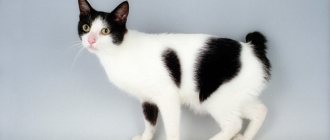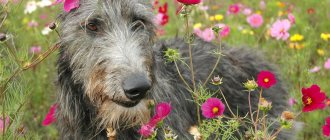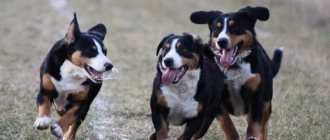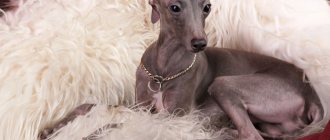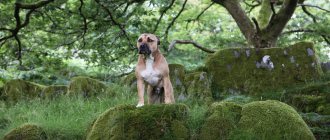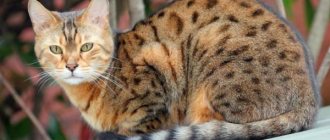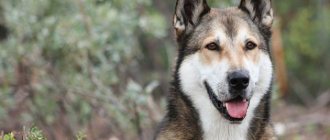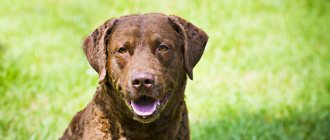Spaniels are a group of breeds that include a wide variety of dogs in purpose and size - from large hunting dogs to decorative dwarf dogs.
It includes Cocker Spaniels, English Springers, Sussexes, Field Spaniels, Irish Water Spaniels, German Wachtelhunds, Breton Espanolas and even Japanese Chins.
Japanese Chins or, as they were previously called because of the characteristic appearance of their ears, Japanese Spaniels, are a decorative breed of dogs.
The history of which is shrouded in mystery.
Today, due to their cute appearance and balanced character, these noble animals are one of the most popular companion dogs in the world.
Origin story and what it looks like in the photo
The Japanese Chin is one of the oldest breeds, the origin of which has not yet been precisely established..
One version says that its representatives were the sacred dogs of Buddha, another that the ancestors of these dogs are Tibetan Toys, according to the third version, Japanese Chins are the direct heirs of the Chinese Pekingese.
In ancient Japan, Chins were treated almost like royalty: they lived in large gilded cages and had personal servants.
Peasants were forbidden to keep these dogs; violation of the ban was severely punished; even the death penalty was not ruled out.
Japanese Chins could belong only to representatives of the upper classes, delight and amuse them, and also decorate the famous palaces of China, Japan and Korea.
The rulers of the Japanese Empire gave representatives of this breed to foreign ambassadors, thus showing them special respect. This is exactly what happened at the beginning of the 19th century. cinchines began to appear in Europe.
In the United States, they learned about these dogs only after Japan opened its borders in 1853.
After the First World War, the breed was on the verge of extinction; active work on its restoration began in the 50s of the 20th century. by members of American and English breed clubs. This selection led to the emergence of the modern type of Japanese Chin.
The breed was officially recognized by the International Canine Association in 1977, at which time the first standard was drawn up, and the dogs began to be called “Japanese Chin” and not “Japanese Spaniel”, as was previously the case..
History of the origin of Japanese Chins
The history of the Japanese Chin goes back a long way. The Japanese believe that the Chin is their national dog breed, which has not been exported outside the country for more than 1000 years. Koreans say that chins were bred in Korea and given as a gift to the Emperor of Japan as a sign of eternal friendship. Almost the same version of the origin of the Japanese Chin is put forward in China.
Be that as it may, the first mention of dogs of this breed appeared in Japan and dates back to the 8th century AD. In the 12th-14th centuries, a real cult of Japanese chin developed in the land of the rising sun. Poems were dedicated to dogs, they were depicted in pictures, and jewelers decorated vases and sculptures with images of animals. Japanese aristocrats did everything possible to rid the breed of genetic diseases. In some cases, breeders could trace 10 tribes of their pets.
Commoners were strictly forbidden to own these dogs and the death penalty was imposed for breaking the law. These dogs came to Europe only in the 17th century. They were smuggled out by Portuguese merchants and presented to the Spanish king. In the 19th century, dogs found their way to the United States, and then spread throughout the world.
In the early 20th century, dogs proved to be excellent companions and were introduced to the court of Queen Victoria. Before the First World War, selection work was carried out to improve the breed, but it was only possible to continue it in the 50s of the last century.
Interesting fact: In Russia, this breed remained completely unknown for a long time. For the first time, purebred Japanese Chins came to the USSR only in the 80s. These were first-class dogs and it was they who became the progenitors of most of the Chins bred in Russia.
Interesting Facts
- In Japanese, "hin" means jewel.
- It is believed that these dogs are able to protect the house from dark forces and evil spirits.
- There is a belief that Chins were fed rice and sake to prevent them from growing too large.
- Representatives of this breed were favorites of the British Queen Victoria, Nicholas II, US President Franklin Pierce, and Marshal Zhukov.
Suitable nicknames for the JAPANESE CHIN dog breed
When an owner or breeder wants to get these dogs, he must remember that the dog does not have simple roots, so he must be given an appropriate name or nickname.
It may include “the name and appearance of the dog,” “the name and homeland of the breed,” and “the name and character of the chin.” Therefore, let's move on to considering the most preferred names for the next half of the representatives of this dog breed.
| Optimal dog names | ||||
| dog's name and appearance | nickname and homeland of the breed | Hina's name and character | ||
| 1 | Male half | “Abby”, “Bambu”, “Wookie”, “Danko”, “Zhorik”, “Lokki”, “Maize”, “Manu”, “Paco”, “Sancho”. | "Akeno", "Isami", "Kado", "Osamu", "Takumi", "Hotaka". | "Ice", "Ulrich", "Cicero", "Erwin", "Yusuf". |
| 2 | Female half | “Andi”, “Indy”, “Hardy”, “Cherry”, “Ellie”. | "Ami", "Izumi", "Kagami", "Kaede", "Kameko", "Kasumi", "Sakura", "Sumi", "Yui". | “Vassa”, “Vega”, “Verbena”, “Jasmine”, “Isis”, “Medea”, “Evita”. |
Description and standard
Japanese Chins are miniature and graceful dogs with a harmonious physique and proud bearing..
The length of the body of representatives of this breed should be equal to the height at the withers, however, in bitches a slightly elongated format is possible, which is due to the need to bear offspring.
Breed standard:
- the skull is wide, rounded, the transition from the forehead to the short and upturned muzzle is sharp, the stop is deep and depressed;
- the bridge of the nose is short and wide, the nose is located in line with the eyes, pigmented black or to match the coat color spots;
- straight or scissor bite;
- the ears are long, hanging, V-shaped, set wide, abundantly covered with hair;
- the neck is moderately long, without dewlap, smoothly blending into the withers;
- the eyes are large, round, the iris is almost black;
- the back is straight, short, the lower back is rounded;
- The chest is wide, the ribs are arched;
- tucked stomach;
- the tail is set high and lies on the back;
- the forelimbs are straight, set parallel, the hind limbs with slight angles;
- The paws are small, oval, the toes are tightly clenched.
The coat is straight, silky, thick and long . There is practically no undercoat. The ears, tail, hips and collar have more fur than other parts of the body.
Appearance of the Japanese Chin
Distinctive characteristics of the Chin are its miniature size and neat build. Small dogs have the highest value. Girls often have a more elongated torso.
Frame
The dog's back is straight and small, the lower back is wide, close to a circle in shape, the chest is widened, the ribs have a moderate bend, and the belly does not protrude.
Head
The skull is also quite wide and rounded, the forehead and muzzle are located quite close. The pads above the upper lip are quite pronounced. The nose is in line with the eyes, the nostrils are wide.
Teeth and jaws
The teeth are quite strong and white. You can often find cinchonas with incomplete teeth, for example, with missing lower incisors. This is accepted as a standard and is not a vice. The bite is mostly straight, but scissor bite and underbite also occur. This also does not apply to the defective development of quinine. The jaws are small and quite advanced.
Eyes
The Japanese Chin's eyes are set wide apart, round in shape and black in color. If the eyes are too large or too prominent, this is considered a deviation from the standard. If the Chin has purely Japanese roots, then its muzzle is characterized by a certain amazement.
Ears
The ears are triangular in shape and wide, hanging down when calm, but can rise slightly when alarmed. Long hair covers the ears. The ear is thin and light, and not heavy compared to a spaniel.
Neck
The neck of the Japanese Chin is short and set slightly high.
Limbs
The forelimbs have thin and smooth forearms. The area below the elbow is densely covered with hair, which smoothly falls down. The hind limbs have angles, but they are not so obvious. The back of the thighs is “dressed” in long hair. The paws are shaped like an oval, a little like a hare's. The fingers are pressed tightly against each other. It would be nice to have fluffy tassels between your fingers.
Movement
The Chin's gait is light and elegant. While walking, he behaves a little arrogantly, raising his paws high.
Tail
The tail resembles a steering wheel in appearance, lies close to the back, and is covered with long hair that falls apart when moving. The dog, like a peacock, straightens its little tail when it is happy to meet its owner or guests.
Wool
The coat of the Japanese Chin is characterized by its smoothness and silkiness. Outwardly, it resembles a long cloak that envelops the dog. There is, one might say, no undercoat at all. The hips, ears and tail have the most fur.
Color
The most common spotted dogs are black and white or white with red spots. Red color varies in intensity, from lemon to chocolate. It is not recommended to use chocolate-spotted quinine for offspring as it may affect the health or life of the puppy. The spots should not be concentrated in one place.
The presence of a white stripe that runs from the forehead to the bridge of the nose is considered attractive.
Character traits
Japanese Chins are smart and quick-witted dogs with a lively and easy-going disposition . Despite their energy, they are not characterized by fussiness - they are moderately active and have a balanced psyche.
Representatives of this breed love care and attention, but at the same time they are self-sufficient and unobtrusive - chins are amazingly able to guess the mood of their owners, they feel and understand when they need to wait a while instead of imposing their company.
Being miniature dogs and not created for any kind of work, Japanese Chins are distinguished by amazing fearlessness, bordering on recklessness - if the owners are in danger, the pet without hesitation comes to his defense and does not give in even to a much larger opponent.
Japanese Chins are accustomed to receiving admiring glances and love to be treated with awe and adoration..
At the same time, they do not tolerate a familiar attitude, and they treat strangers with suspicion and wariness, not allowing them to touch themselves.
When surrounded by a family, dogs behave differently - they are affectionate and friendly, they get along with everyone in the household, but they always choose one person to treat with special love..
Expert opinion
Kozhevin Semyon Kirillovich
Expert dog handler.
One of the main character advantages of Japanese Chins is their unobtrusiveness. Despite the need for the owner's care and thirst for his attention, the pet will never intrude or bother you, especially if it feels that the owner is upset or angry. These dogs have never been used for work and now it is impossible to make watchmen or security guards out of them, however, training is still necessary, as well as early socialization - without this, the puppy grows up to be a fearful and timid dog.
Advantages and disadvantages
Representatives of this breed have a lot of advantages, among which most often stand out::
- affectionate and friendly disposition;
- courage;
- devotion;
- cleanliness;
- occasional barking;
- agreeableness;
- unobtrusive behavior and self-sufficiency;
- balanced psyche;
- mind;
- ability to get along with children and pets.
In addition, Japanese Chins do not require complex care, and their coat does not have an unpleasant, specific dog odor.
These dogs don't have many faults.:
- heavy shedding;
- difficulties in learning and training;
- touchiness;
- stubbornness;
- snoring in your sleep.
It should also be taken into account that the brachycephalic structure of the skull causes breathing problems, especially in winter.
Maintenance, care, hygiene
The long, beautiful coat of the Japanese Chin is its main advantage and requires constant attention. In order for it to always look presentable, be a decoration for your pet, and not get tangled, it needs to be combed every day.
When chins become dirty, they are bathed using special shampoos for dogs. Instead of bathing, dry shampoos are often used to clean the fur. The dog's ears should be regularly examined for inflammatory diseases, dirt and infections. They are cleaned with a cotton swab and a special product.
Grooming is not provided for these dogs. But some owners trim their quinine in the summer so that the pet does not feel hot.
After swimming
You also need to regularly show your pet to the dentist to identify the presence of tartar and gum inflammation. Bad breath can be eliminated by brushing your teeth every day. The claws on the paws are trimmed as they grow.
Difference from Pekingese
It is believed that Japanese Chins and Pekingese had a common ancestor and these dogs were previously classified as the same breed, but there is no documentary evidence of this.
Be that as it may, representatives of these breeds are very similar both in appearance and in character and habits.
However, there are some differences between Chins and Pekingese.:
- the homeland of the Chins is Japan, the Pekingese are China;
- Pekingese weigh slightly more than quinines;
- cinchona, due to its long limbs, is significantly higher.
In addition, the coat of Japanese Chins is less fluffy, but smoother and flowing . What distinguishes these dogs from other similar breeds is their original coat color.
Color variations
The official breed standard for Japanese Chins suggests only 2 coat colors: white-black and white-red.
White black
The most common color variant, in which there are black spots on the main white color of the coat . The lobe is pigmented black; the presence of pink spots on it is unacceptable.
White-red
The white coat has red spots, the shade and intensity of which can vary from light lemon to chocolate . The nose is pigmented to match the spots on the coat; there should be no pink spots on it.
CAREFULLY!
Individuals with dark chocolate spots should not be bred, as their puppies are often born sick and even dead.
With any color option, the spots should be symmetrically located around the eyes, covering the ears and body, on which they can be located randomly or balanced, which is more preferable.
In addition, it is desirable to have a white mark running from the bridge of the nose to the forehead, on which there may be a small black spot, which is called the Buddha finger.
Coat and shedding period of the JAPANESE CHIN dog breed
These dog breeds are very unpretentious in handling and living conditions. This is primarily due to the fact that they have a unique coat. The body of this wonderful animal is covered with long silky hair. It is soft to the touch, almost straight. There is rich fur on the throat, hips, and tip of the tail.
But on the head there is short hair. As a rule, this breed of dog has white, black and red spots on its coat. If the owner purchases an animal without spots, then this will be a true defect of this type of animal. In some representatives, the tips of the hair may be slightly denser in structure.
Males have much thicker fur, so they have a very presentable appearance. As a rule, if an owner decides to take a dog to a show, it is best to purchase a male. Dirt practically does not stick to such wool, but if this happens, the dirt can be removed quite easily. After all, the fur of this animal has the ability to clean itself. Thanks to this, the animal does not emit a strong dog smell.
Therefore, if the dog is constantly cared for, it will not have any smell at all. Speaking for representatives of this breed at an early age, the puppies have downy fur. It is very smooth and soft. But with age it becomes tougher. The completion of fur formation is observed at the age of 1.5 years. The main feature of such animals is that they molt twice a year.
Shedding is moderate. More pronounced in females. During this period, the owner must transfer the animal to a special diet with an enhanced vitamin complex. If you feed him dry food, then there is no need to use an additional vitamin base.
In order for the animal’s shedding period to pass faster, it is necessary to carry out regular grooming of the animal. It is also recommended to carry out regular washing using specialized shampoos for dogs. It should be remembered that contaminated hair does not grow on these dogs.
Therefore, constant washing not only removes dead hair, but also quite quickly restores the growth of silk. It is also necessary to regularly massage the animal using a special brush for combing. Based on the above, it should be concluded that the animal is easy to care for. Such animals do not require a large amount of exercise. But they need attention, you need to play with them.
Is he good with children and does he get along with other pets?
Chins get along well with children - these dogs are not characterized by aggressive behavior, especially towards children. At the same time, it is better to have such a pet for families with school-age children, since a younger child can inadvertently injure a miniature and fragile dog.
Due to their friendly disposition, lack of hunting instincts and tendency to dominate, representatives of this breed easily get along with other pets, including cats and rodents.
Diseases of the JAPANESE CHIN dog breed
Like any other animal, this type of unique dog is susceptible to a number of diseases that are characteristic of dog breeds with flat faces. It happens that during sleep such dogs snore and wheeze. Any owner and breeder should take these points into account when keeping animals.
Therefore, you should not be alarmed if such symptoms occur in your dog. Typically, the main types of diseases of this animal are luxation of the patella, cataracts, heat stroke, heart murmur, atlantoaxial subluxation, and corneal ulceration.
These animals have a fairly strong genetic genotype. The dog does not have any specific diseases. Breathing problems and heart problems are quite rare.
This can only be found in old age. If you suspect a serious illness, you should seek help from a qualified veterinary specialist. He will be able to correctly examine the animal, make an appropriate diagnosis, determine the correct method of treatment and prescribe effective therapeutic veterinary medications. However, don't worry about the little things.
How to properly care
Japanese Chins require simple but regular grooming. The owner's main efforts should be aimed at caring for the coat, which sheds profusely and can become tangled.
Wool and bathing
The Chin's coat should be brushed daily with a massage brush; during shedding, a furminator should be used - this will help get rid of dead hairs and avoid the formation of tangles.
NOTE!
Representatives of this breed do not need to be cut; only trimming the fur between the toes is allowed.
These dogs should be bathed once every 3-4 months, using a mild shampoo appropriate for their coat type and conditioner..
More frequent washing is not required, since their coat does not retain dirt, and a small amount of it is easily removed during combing.
Ears
Inspect your ears weekly and, if necessary, clean them of wax and dust accumulation with a cotton pad soaked in a special lotion or hydrogen peroxide.
Claws
The nails of representatives of this breed grow quickly and tend to bend and split, which prevents the dog from walking..
If they do not wear down on their own during walks, they should be shortened with a guillotine nail cutter every 7-10 days, but for some individuals monthly trimming is enough.
Teeth
Brush your teeth several times a week with a special brush and toothpaste for dogs - this prevents the formation of plaque and tartar.
Eyes
Cinchonas are prone to increased lacrimation, which often causes the eyes to become sour . Therefore, they should be wiped daily with a lint-free cloth or cotton pad soaked in tea leaves and furatsilin solution.
How to choose a puppy
Purebred dogs are divided into several classes:
- Pet class. Dogs are pets for the soul.
- Breeding class. Esterter of high-level breeding class dogs.
- Show class. These are real aristocrats, there are not many of them. To buy such a dog, you will have to wait a long time for your turn and pay the full price.
If you decide to purchase a breed or show class china, start by visiting exhibitions.
There you will determine which kennel dogs you like, and you will be able to negotiate with the owner about purchasing a puppy from certain parents.
Chins really need communication with their owner and constant confirmation of their special relationship. Khin must be sure that he is the most loved, beautiful and smart, otherwise he will be nervous and may get sick
As in other breeds, Chin males are larger than females, they are more independent and express their gender more clearly.
Male puppies need to be raised strictly; walks with them last longer, and constant supervision is required.
Chin bitches are docile and obedient, all their attention is focused on their owner.
When contacting a breeder, clearly formulate your requirements, and they will select a suitable dog for you.
If you decide to trust your heart and choose a puppy yourself, pay attention to the following points:
- The puppy's development should correspond to its age.
- Between the plump and skinny puppies, choose the first.
- The coat should be, like that of dogs of the Cavalier King Charles Spaniel , shiny and without bald spots, the skin should be free of scratches and wounds, the eyes and ears should be clean.
- The dog should not limp.
- A swollen tummy and a warm nose indicate malaise.
- A healthy puppy has a good appetite, a cheerful mood and a clear look.
Japanese Chins get along easily with children and are quite friendly as long as they enjoy the game.
All puppies are adorable, but you must understand that they will soon grow up and lose their childish charm.
Chat with the puppies, and you will definitely develop a mutual sympathy with one of them.
At such moments, buyers forget about their demands and take away with them the chin that first climbed onto their laps or licked their nose.
The Japanese Chin does not like to swim very much. Bathing procedures three times a year will be enough
Life expectancy, health and major diseases
On average, Japanese Chins live 10-14 years, but they cannot be called the owners of good health.
Representatives of this breed are prone to many diseases typical of toy dogs and animals with brachycephalic skulls:
- dropsy of the brain;
- GM2 gangliosidosis;
- distichiasis;
- cataract;
- progressive retinal atrophy;
- entropion of the eyelid;
- misalignment of the jaw, multiple teeth, false polyodontia;
- digestive system dysfunction;
- underdevelopment of the reproductive system;
- dislocations of the elbow and kneecaps;
- necrosis of the femoral head;
- laryngeal paralysis;
- glaucoma;
- chronic rhinitis;
- allergy;
- conjunctivitis;
- dislocation of the eyeball;
- tracheal collapse;
- nostril stenosis.
Most diseases can be avoided by providing your pet with proper care and regular visits to your veterinarian for routine checkups..
Diseases and health problems
When planning to buy a Japanese Chin puppy, you should take into account the fact that these are quite sickly dogs. They are characterized by the fragility of small dogs and have their own “signature” sores.
The unusual shape of the skull and snub nose add to health problems. Shortened facial bones of the skull lead to quite serious diseases associated with breathing. Both in cold and hot weather, these dogs breathe with great difficulty. Therefore, in high and low temperatures, it is recommended not to walk the dog at all. Moreover, during puppyhood, Japanese Chins develop hydrops of the brain and this disease is incurable. Such dogs are simply euthanized.
Another big problem with these dogs is their bulging eyes. In 10% of dogs, a second row of eyelashes may begin to grow (distichiasis), resulting in permanent irritation of the mucous membrane of the eye. The extra row of eyebrows is removed using a simple operation. Also, Chins often have dislocation of the eyeball or strabismus. It is recommended to regularly wash your dog's eyes with a solution of tea or chamomile.
Due to their underdeveloped lower jaw, Japanese Chins cannot chew their food thoroughly. This leads to chronic diseases of the digestive tract, and, as a consequence, to volvulus.
Like all other small dogs, Chins have fragile skeletons and weak joints. They often suffer from dislocations of the hind limbs and necrosis of the hip joint. The Japanese Chin must be handled very carefully so as not to injure the dog with an awkward touch or too tight a hug. After 10 years of life, dogs of this breed worsen all chronic diseases, deafness progresses and vision problems begin.
Nutritional Features
For healthy growth and development, Japanese Chins require a balanced diet based on protein and also containing carbohydrates, fats, vitamins and minerals.
The type of feeding depends on the preferences of the owner and his ideas about what is healthier for the pet - it can be industrial food or natural products.
Ready-made food is more convenient to use and dose; it does not require time to prepare food for the dog and contains all the necessary macro- and microelements.
At the same time, in the event of an allergy to one of the components of the food, a complete replacement of the diet will be required, and the use of products made from low-quality raw materials and containing chemical additives will negatively affect the health of the pet.
IMPORTANT!
The most popular foods: Acana, Orijen, Artemis, Canidae, Almo Nature, Arden Grange, 1st Choice, Happy Dog, Royal Canin, Brit Premium.
When feeding a dog on a natural diet, you should include:
- lean meat - turkey, chicken, beef, veal;
- beef by-products – kidneys, heart, liver, lung, tripe;
- sea and ocean fish;
- porridge – rice, buckwheat, oatmeal;
- boiled yolk;
- vegetables and fruits;
- fermented milk products - cottage cheese, kefir, natural yogurt.
It is forbidden to feed chins:
- legumes;
- fatty meat;
- potatoes;
- river fish;
- citrus fruits;
- fatty and fried foods;
- sweets;
- smoked meats and sausages.
It is enough to feed adult individuals 2 times a day, dividing the recommended 125 g of food into several feedings.
Proper diet for the JAPANESE CHIN dog breed
The owner or breeder must remember that an optimized diet is required for the health of the animal. To do this, all types of amino acids in products must be balanced. To do this, food must have an optimal set of calories. These dogs eat little.
The protein diet should include 2/3 of the daily requirement. The following foods are great for this dog: turkey, chicken, raw beef, and beef tails. Breast feeding is best if it is poultry. It is given only in boiled form. This also includes a combined meal with boiled liver, tripe and kidneys.
You can give rice. Ocean fish is given once a week. Boiled eggs are also great for this animal. Suitable fruits and vegetables include carrots, pumpkin, zucchini, sweet potatoes, green apples, pears and various berries. Vegetables are given raw, boiled and baked, grated and finely chopped. Animals are allergic to wheat products. Sometimes the skin turns red and hair falls out. An additional source of nutrition and vitamin C must be present.
How to train correctly?
Japanese Chins are smart, they quickly remember commands, and if desired and with due diligence, they can be taught various funny tricks.
Training is best done in a playful way, without forcing the dog to repeat the same command over and over again - 5-6 times is enough..
You should not scold or hit your pet, you should also not roughly touch its face or tail or make sudden movements - this can lead to disorientation of the dog and provoke aggressive behavior.
Japanese Chins are rarely food eaters; they respond better to encouragement in the form of praise.
Despite their miniature size, representatives of this breed must be taught the basic commands “Fu”, “Come to me”, “Place”, “Nearby” - they help control the pet during walks and provide more guarantees of its safety.
The commands “Sit”, “Lie down”, “Give me a paw” will not be superfluous - even if the dog does not participate in exhibitions, a set of these commands will help make caring for it easier at home.
Training should begin at about 3 months, first at home, where the puppy is not distracted by anything and the whole environment is familiar, later you can train him on the street during walks.
How to choose? Boy or girl?
It is better to purchase a puppy not from hand, but from a specialized nursery, where breeders guarantee its health and purebred.
Before purchasing, you should inspect the premises where the dogs are kept, observe their behavior, meet the parents of the future pet and ask the breeder about their health.
The puppy you like the most should be carefully examined: it should have clean ears without redness, clear, mischievous eyes, pink gums, white teeth without signs of underbite or overbite, soft and shiny coat.
The baby should be active, cheerful, and have a good appetite.
"Cow" hind legs, instability, too low sternum, conjunctivitis, rhinitis, lameness and other symptoms of pathologies or abnormal development are unacceptable.
How much do dogs cost in Russia?
The cost of Chin puppies, like any other dog breed, depends on several factors: the class of the animal, the presence of a pedigree, and the exhibition merits of the parents. If a puppy was born from eminent parents and has a good pedigree, then most likely he will be listed as a show class representative, and his price can reach up to $1000 . If you are not going to raise a champion, then you can buy a healthy puppy with ordinary parents and without a pedigree - for $300 cheaper. Healthy dogs that do not meet the standard in one way or another cost the least. But even here the price is unlikely to be below $400-500.
These are the prices in specialized nurseries, where you should purchase a puppy for safety reasons. If you decide to buy a Chin from an advertisement, then the price may be lower, but the risk of purchasing a non-purebred and unhealthy puppy increases several times.
Video
Nurseries in Russia and CIS
- "Evelveys", Russia, St. Petersburg;
- “Medangen”, Russia, Ekaterinburg;
- PradoRocks, Russia, Bryansk;
- “Legend of Kings”, Russia, Tula;
- “Hin Matsuri”, Belarus, Gomel;
- “Sunny Country”, Belarus, Vitebsk;
- Fluffy Pet, Ukraine, Dnepropetrovsk;
- Rodnichok iz Tiger Sada, Ukraine, Poltava;
- “Playful Ray”, Ukraine, Nikopol.

